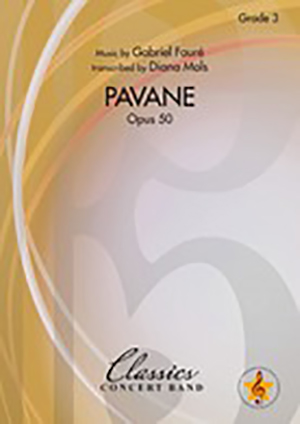Pavane
| Sound File | |
|---|---|
| Sample Score | SHOW PDF |
| Composer | Fauré, Gabriel |
| Arranger | Mols, Diana |
| Instumentation | Concert Band |
| Grade | 3 |
| Duration | 5:00 |
| Genre | Concert Music |
| Included Parts | |
| Format | DIN A4 |
| Article | SMP-10-0041 |
- Description
Beschreibung
Gabriel Urbain Fauré (Pamiers, May 1845 – Paris, November 1924)
The Pavane in F-sharp minor, Op. 50, is a pavane by the French composer Gabriel Fauré written in 1887. It was originally a piano piece, but is better known in Fauré’s version for orchestra and optional chorus. Obtaining its rhythm from the slow processional Spanish court dance of the same name, the Pavane ebbs and flows from a series of harmonic and melodic climaxes, conjuring a haunting Belle Époque elegance. The piece is scored for only modest orchestral forces consisting of string instruments and one pair each of flutes, oboes, clarinets, bassoons, and horns. A typical performance lasts about six minutes.
The original version of the Pavane was written for piano and chorus in the late 1880’s. The composer described it as “elegant, but not otherwise important.” Fauré intended it to be played more briskly than it has generally come to be performed in its more familiar orchestral guise. The conductor Sir Adrian Boult heard Fauré play the piano version several times and noted that he took it at a tempo no slower than 100 quarter notes per minute. Boult commented that the composer’s sprightly tempo emphasised that the Pavane was not a piece of German romanticism, and that the text later added was “clearly a piece of light-hearted chaffing between the dancers”.
Fauré composed the orchestral version at Le Vésinet in the summer of 1887. He envisaged a purely orchestral composition, using modest forces, to be played at a series of light summer concerts conducted by Jules Danbé. After Fauré opted to dedicate the work to his patron, Elisabeth, comtesse Greffulhe, he felt compelled to stage a grander affair and at her recommendation he added an invisible chorus to accompany the orchestra (with additional allowance for dancers). The choral lyrics were based on some inconsequential verses, à la Verlaine, on the romantic helplessness of man, which had been contributed by the Countess’s cousin, Robert de Montesquiou.
The orchestral version was first performed at a Concert Lamoureux under the baton of Charles Lamoureux on November 25, 1888. Three days later, the choral version was premiered at a concert of the Société Nationale de Musique. In 1891, the Countess finally helped Fauré produce the version with both dancers and chorus, in a “choreographic spectacle” designed to grace one of her garden parties in the Bois de Boulogne.
This arrangement is for wind band.


